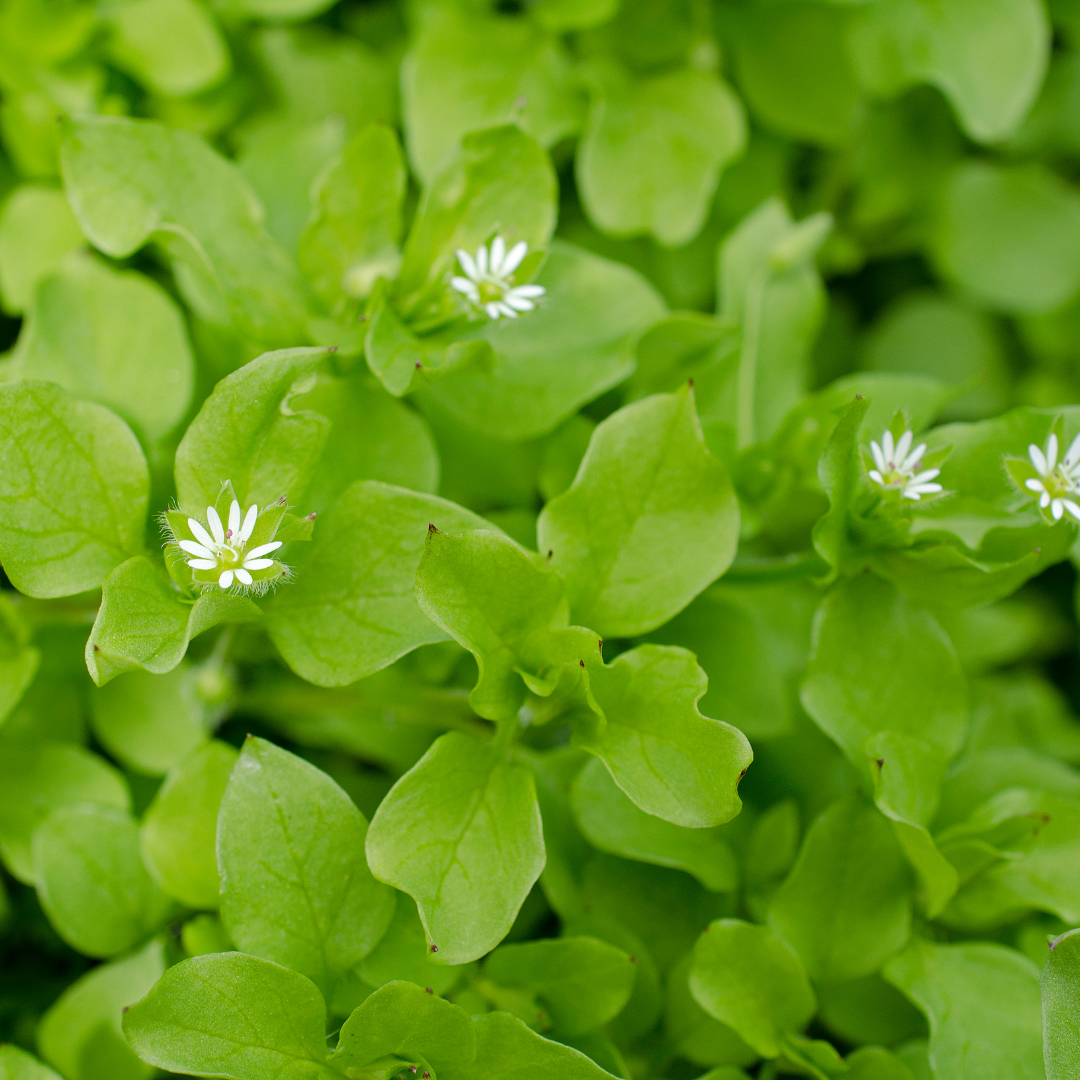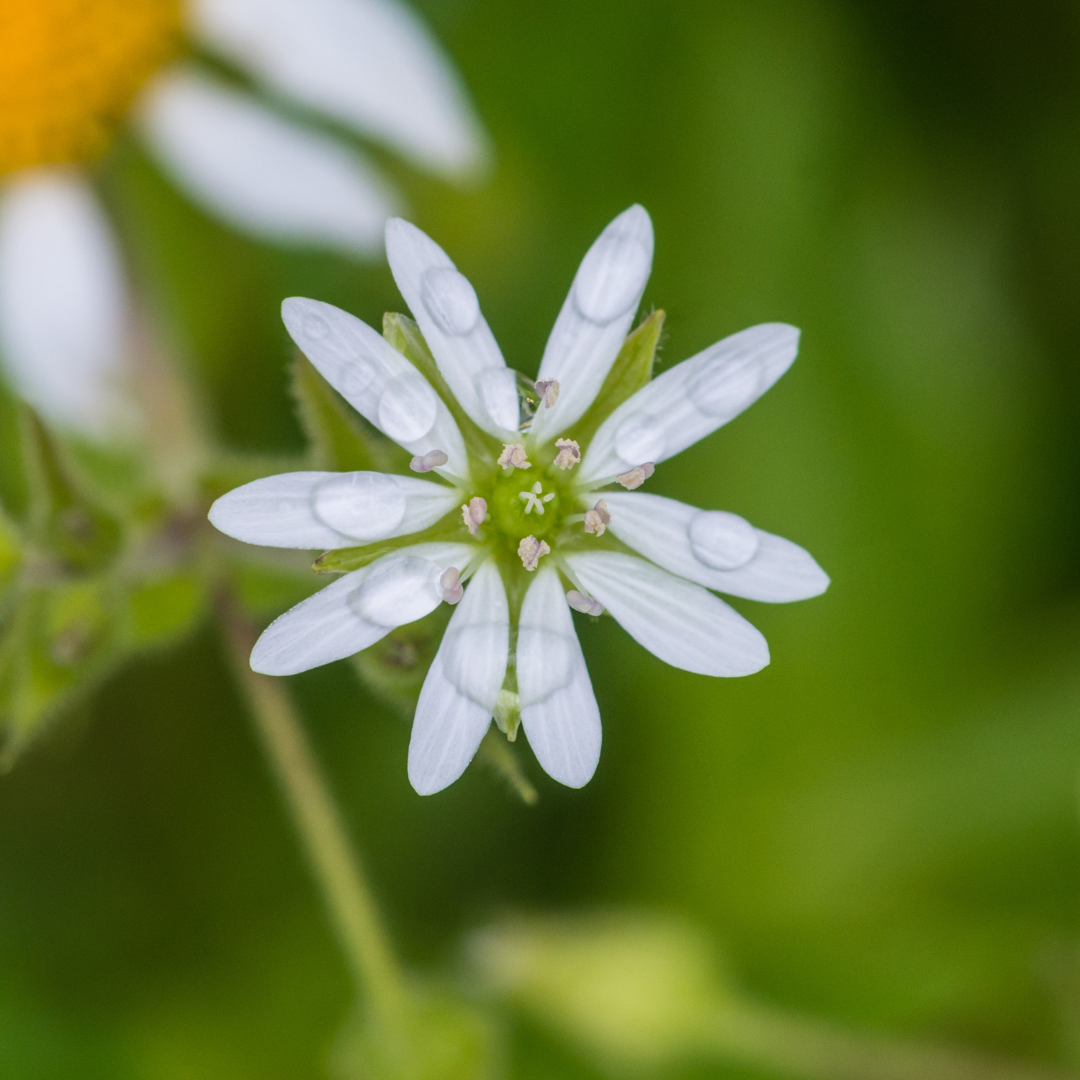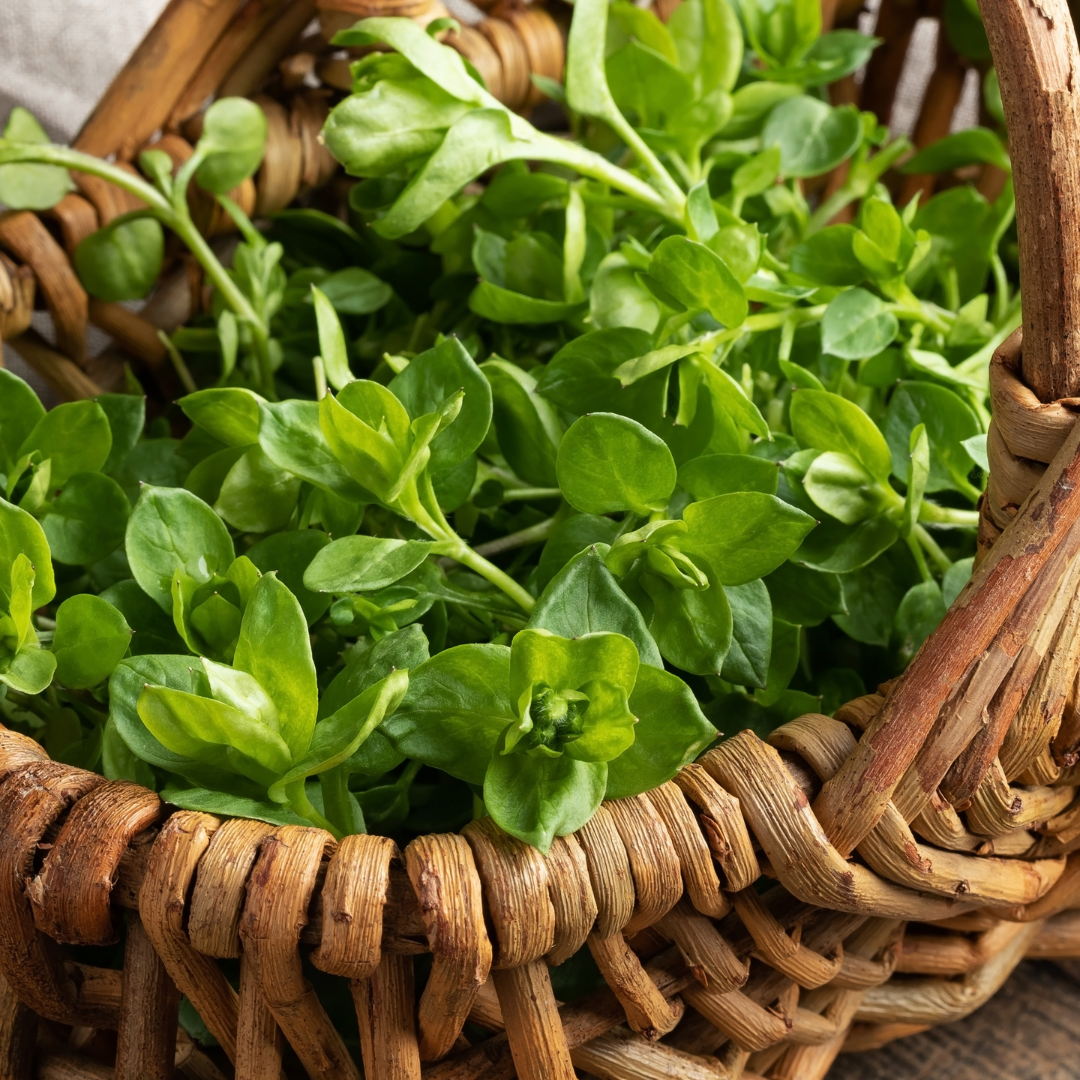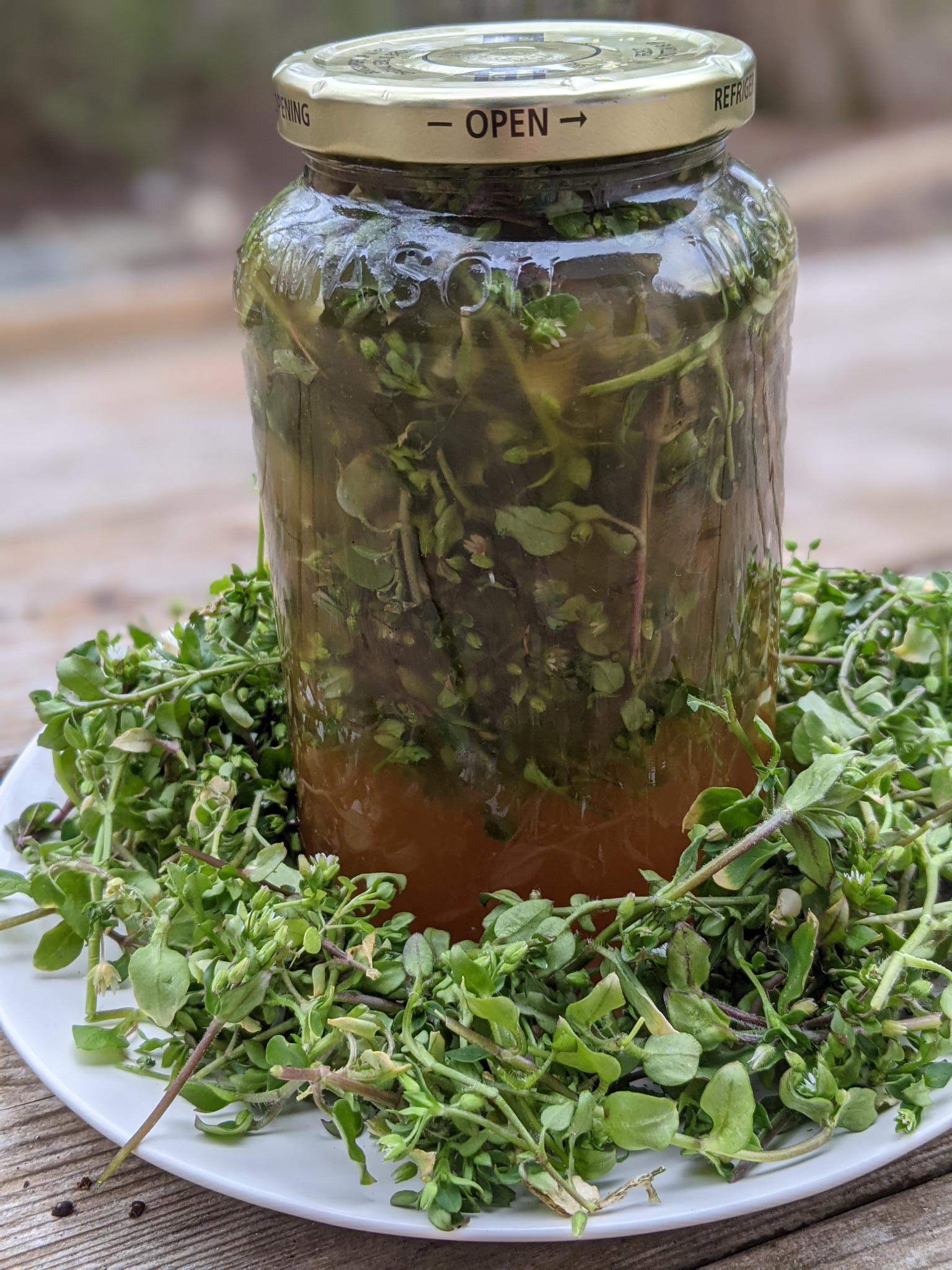Chickweed is one of the first greens to pop up in spring. She is often overlooked as a weed, but she’s an herb known for high amounts of minerals and vitamins. Learn about the amazing health benefits of chickweed—and how to use this wild plant as food and medicine in your life!
In the carnation family, Chickweed (Stellaria media) is also known as starweed, starwort, winterweed, and chickenwort. This herb is native to Europe but has since made its way to North, Central, and South America, as well as Africa, Australia, and Asia.
Groundcover Springtime Medicine
Chickweed can easily be overlooked, as she often grows low to the ground and to the untrained eye, might be simply considered a weed. Many gardeners consider her a weed, but that is true of so many of our beautiful medicinal wild plants. The connection to our wild foods has been lost to many in the modern age. It’s time to connect back to the wild food and medicines our ancestors would have used.
Discover 20 edible “weeds,” i.e., wild plants in your backyard!
You can find chickweed growing wild in your garden, yard, parking lots, and even fields. She is a soft blanket protecting the soil. You’ll see chickweed at the same time that nettles, chives, and spring ephemerals arrive. Once you learn to identify her, you will notice her all over during the spring.
Chickweed is known as a nutritive herb, meaning it can be eaten for food and used as medicine. She’s unassuming. She’s not flashy. She’s resilient and steadfast. She’s great at taking care of herself and those around her. She’s multi-faceted. She can be eaten raw in salads or sandwiches, made into a yummy pesto to use as a topping, or infused into tea. As a medicine, chickweed can be dried to make herbal oils and then salved for a soothing skin remedy.
How to Identify Chickweed

The tiny flowers look as if they have 10 thin petals; these are actually five petals that are deeply cleft.
Her flowers are white, and her leaves grow opposite each other.
She is a sprawling herb, meaning she spreads out across the ground. When she’s in flower, her stems can grow upward and get up to a foot tall, but most of her will still be growing along the ground. Her leaves are smooth and neither toothed nor serrated.
If you look very closely and hold the stem up to the sun or a light, you can see one thin strip of tiny hairs along her stem.

This sweet, demure herb comes up in early spring, sprawling along the ground, producing her sweet tiny white flowers, early spring through early summer, right when we need her medicine the most. In fact, she is often the first wild food and medicine to arrive in the spring.
I absolutely adore chickweed in the garden because she offers so many benefits to us, including in our gardens. She grows like a blanket on the soil, so I will allow her to grow between the rows of the garden or sometimes even in the garden beds along with other taller growing garden veggies such as kale or Swiss chard.
Not every gardener wants a plant like chickweed in their beds, perhaps because they don’t value chickweed as food or medicine. Chickweed can take over a garden bed if you let it. But I find, she is very easy to turn right into the soil if there is an area where you do not want her to be. You can also grow her in an area other than a garden bed if you are concerned about her taking over.
In our gardens, she keeps the garden soil covered and moist in the spring. She even helps bring nutrients up into the soil, benefiting the plants around her. When our warm-weather transplants, such as tomatoes and peppers, are ready for the garden, she is beginning to die back.
To Harvest Chickweed
Simply give her a haircut! Trim the top half of her leaves and stem when harvesting for food, as the younger leaves are more tender. When harvesting for medicine, you can trim a bit lower down. Don’t cut all the way down. Leave enough for her to grow as you can receive multiple harvests in a season.
If you are harvesting in your own garden, you do not need to wash unless you feel it’s necessary. Rinsing and patting dry is a great idea when harvesting in other yards, parks, etc. Of course, always do what feels right to you.

The Medicine of Chickweed
- She’s anti-inflammatory and soothing to the internal tissues and is known for helping with recovery from sickness such as the flu.
- Chickweed is also a diuretic, meaning it helps the kidneys move waste (and you’ll urinate more). She’s particularly excellent to consume in spring to help us flush our system after months of less movement, heavier foods, etc.
- She is a blood builder and mover. She is higher in iron and zinc than many of the cultivated greens, such as spinach and kale.
Times to Look for Chickweed for Healing
- Chickweed is extremely high in minerals and is known to nourish folks back to health after a major illness or stressful time.
- She’s amazing at nourishing a new/nursing mama.
- She aids those dealing with acne, psoriasis, and eczema (combine with Red Clover and Burdock internally for an especially awesome combo).
- She can be consumed as a tea to soothe a sore throat and cough.
- She can be used to stimulate digestion and bowel movements.
- She can aid in detoxification.
- She helps to move and build blood—so stagnant energy can be aided by chickweed.
- She can help with heartburn or stomach ulcers when used as tea.
- She can be used topically as a poultice for rashes, bug bites, sunburns, etc.
Because of her mineral and mucilage content, I’ve found the best way to receive those benefits is through eating chickweed, drinking it as tea, or making it into vinegar. Tinctures do not pull out the minerals and the soothing quality of the mucilage.
How to Eat Chickweed
- Parts to eat include the tender leaves, tender stems, and flowers.
- You can eat her just like any green, the top young leaves being the most tender and delicious.
- Add her to salads, wraps, sandwiches, or steamed greens.
- She also makes a fabulous pesto.
Using Chickweed as INTERNAL medicine
- You can dry her leaves and flowers for use as a tea or an herbal infusion; fresh chickweed also works beautifully.
- You can make an herbal vinegar to add to foods or take straight. It’s best to use wilted or dried chickweed when making your vinegar to keep the water content low.
Using Chickweed as EXTERNAL medicine
Chickweed’s most notable claim to fame just might be her soothing nature for our skin.
- She makes an amazing soothing herbal oil, which then can be made into a salve. You want to use dried chickweed when making your herbal oils to avoid introducing too much water. Chickweed is very moist.
- She can also be used as a poultice on the skin for scrapes, bug bites, and stings.
Chickweed Vinegar
Vinegar is a beautiful way to preserve minerals. The acidity pulls the minerals into the vinegar and helps to preserve the medicine for months. When I say vinegar, I am speaking of apple cider vinegar—always organic.
Apple cider vinegar is said to help improve blood pressure, support healthy blood sugar levels, support digestion, and improve skin quality—and the list goes on.
Using dried herbs will mean a longer-lasting vinegar, although you can certainly use fresh. The water inside the fresh herbs will dilute the vinegar, which lowers its acidity and renders the vinegar less shelf-stable (the acidity of the vinegar is what keeps microbial growth at bay).
You can refrigerate vinegar made from fresh herbs for a longer shelf life. Although many people (including myself) still leave their vinegar at room temperature after straining, these herbal vinegar will inevitably have a shorter shelf life than vinegar made from dried herbs. Watch for signs of mold growth or fermentation to determine if your vinegar has spoiled. Things like bubbles, off or putrid smells, and visible mold are all signs that the vinegar has turned and it’s time to dump in the compost. I find that my herbal vinegars last about 4 months unrefrigerated.
To Make Chickweed Vinegar

Add your chopped Chickweed into your jar, filling loosely, 3/4 of the way. Use either dried or fresh Chickweed. Dried is a great idea due to the high water content of Chickweed.
Pour over your apple cider vinegar all the way to the top of the jar. Use parchment paper between the jar and lid.
Allow the vinegar to steep for 4 weeks in a cool, dry location.
Strain and use as internally as medicine or to add to meals. I also love adding this vinegar to the bath for dry or inflamed skin, rashes, etc.
Chickweed Pesto
We always have pesto on hand at our house. We use it on our veggie bowls, as a dip for our potato fries or crackers, over eggs, you name it. Chickweed is the perfect wild herb to make pesto because it’s got such a mild taste. The pesto is super high in nutrients and minerals from the chickweed, and we’re keeping it cheese/dairy-free.

Chickweed Pesto Recipe
- 3 cups loosely packed fresh chickweed tops (tender stems and leaves)
- 2 cups loosely packed cilantro or basil, chopped
- 5 to 7 medium garlic cloves, chopped
- 1 1/2 – 2 cups extra-virgin olive oil
- 2 cups whole organic walnuts
- 1- 1 1/2 teaspoon sea salt (to taste)
Wash and drain the chickweed.
Combine all the ingredients in a food processor and process until smooth.
Refrigerate for up to a week.
For long-term preservation, freeze in ice cube trays. Feel free to add more olive oil if you want a thinner pesto. You can also add Parmesan cheese for a more traditional pesto. We like to keep ours dairy-free at home.
Chickweed offers so much to us with very little effort on our part. ‘Tis the beauty of wild medicines. I hope you give her a try!
Chickweed is known as an incredibly safe wild food. Of course, you always want to know for sure what herb you have before you ever ingest or use it as medicine. I recommend cross-referencing multiple sources, such as this article, perhaps an herb book, and a wild edibles guide for your area.
There are a few look-a-likes of chickweed to note:
Mouse-eared Chickweed: more hairy and not as tender, looks very similar, edible but not as tasty.
Persian Speedwell: similar characteristics but flowers are blue and only four petals, no line of hairs on the stem. Not edible.
Scarlet Pimpernel: bears a loose resemblance when not in flower—toxic in large doses!
As with any wild food, each person is unique in how their body will react to a new food, including allergic reactions. Start small and see how your body reacts. If you feel better consuming chickweed, that probably means it’s a great herb for you!
Enjoy learning about nature’s medicine? Now, learn about cleavers, another wonderful wild plant in springtime.














